Salmon is renowned for its delicate texture, rich flavor, and high nutritional value, making it a staple in gastronomical delights for gourmands and health-conscious individuals. One popular method of preparing this delectable fish is baking, ensuring the dish preserves the nutritional value of the omega-rich fish while retaining its luscious and succulent quality. But the question often arises – how long to bake salmon at 400 degrees Fahrenheit? If you share this burning query, fear not, as this article aims to provide practical guidance on mastering the technique of baking salmon.
As with any cuisine, precision in cooking time is crucial in ensuring the salmon maintains its tender texture and succulence while avoiding overcooking or drying out. This comprehensive guide will explore factors contributing to determining the optimal duration of baking salmon at 400 degrees, ensuring a delicious and healthy dining experience. Stay tuned as we unravel the secrets behind achieving perfectly moist, melt-in-your-mouth salmon every single time.
What Are The Benefits Of Baking Salmon At 400 Degrees Fahrenheit?
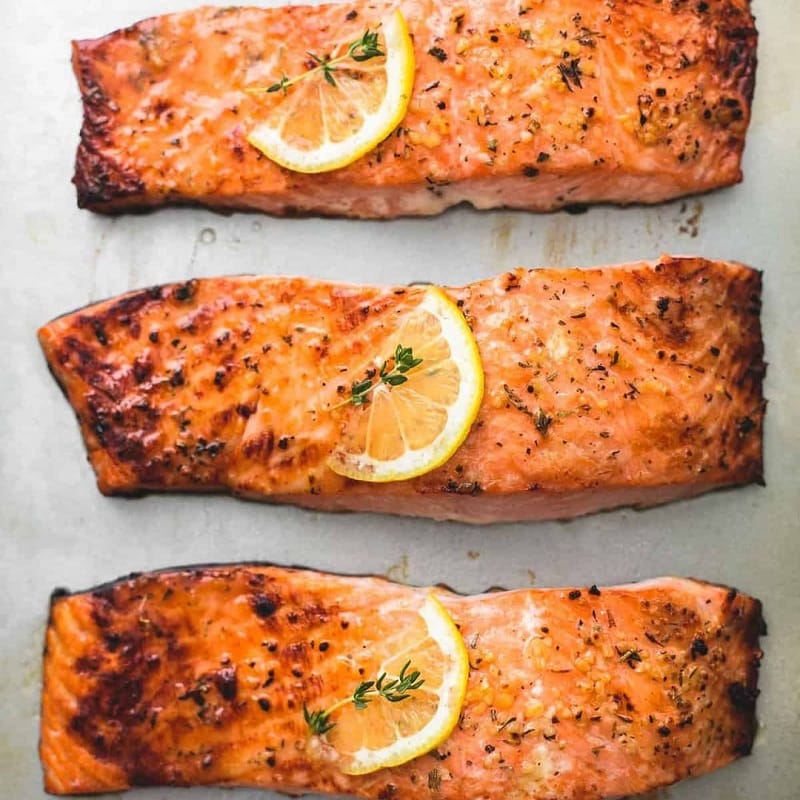
When cooking salmon, you can use many different methods and temperatures. However, in my opinion, baking salmon at 400 degrees Fahrenheit is one of the best ways to cook this delicious fish. Not only does it result in perfectly cooked salmon with crispy skin, but there are also a number of other benefits to this cooking method. Today, I’ll explain why I love baking salmon at 400 degrees Fahrenheit and why you might want to try it too.
First, baking salmon at 400 degrees Fahrenheit is a relatively high temperature for cooking fish. This means the heat can quickly penetrate the fish and cook it evenly. Additionally, this high heat helps to create a crispy skin on the salmon, which is one of the best parts! The skin becomes golden brown and flavorful, while the flesh inside stays moist and tender.
Another benefit of baking salmon at 400 degrees Fahrenheit is that it’s a relatively quick cooking method. Depending on the thickness of your salmon fillets, they should take between 12-15 minutes to cook through. This means you can have a delicious and healthy dinner in no time.
In terms of nutrition, baking salmon at 400 degrees Fahrenheit is a great way to preserve the health benefits of this fish. Salmon is packed with omega-3 fatty acids for heart health and brain function. However, if you overcook your salmon, these healthy fats can start to break down and lose their nutritional value. Baking salmon at a high temperature ensures it cooks quickly and doesn’t lose its nutritional benefits.
Finally, baking salmon at 400 degrees Fahrenheit is a versatile cooking method. You can season your salmon fillets with spices and herbs or squeeze lemon juice for a fresh and zesty flavor. Additionally, you can add vegetables like asparagus or cherry tomatoes to the baking dish to create a one-pan meal that’s both delicious and healthy.
How Long Does It Take to Bake Salmon at 400 With Foil?
It usually takes 15 to 20 minutes to cook salmon at 400 degrees in foil. Of course, individual portions may require slightly more or less time, depending on a few factors, like the thickness of the fillet and personal preference for doneness. To ensure the salmon is fully cooked, it’s important to focus on the internal temperature. Most chefs recommend cooking the fish until its internal temperature reaches 145°F.
How Long Does It Take to Bake Salmon at 400 Without Foil?
Baking salmon at 400 degrees without foil will typically take between 10 and 15 minutes for fillets that are one inch thick. However, larger pieces may require up to 12-15 minutes for the fish to cook through. It’s essential to use a digital cooking thermometer to ensure that the salmon has reached a temperature of 135 degrees Fahrenheit in its thickest part. This will ensure that the fish is fully cooked and ready to enjoy. So, next time you plan to bake some delicious salmon, you’ll know just how long to leave it in the oven!
How Long Does It Take to Bake Salmon at 400 in the Oven?
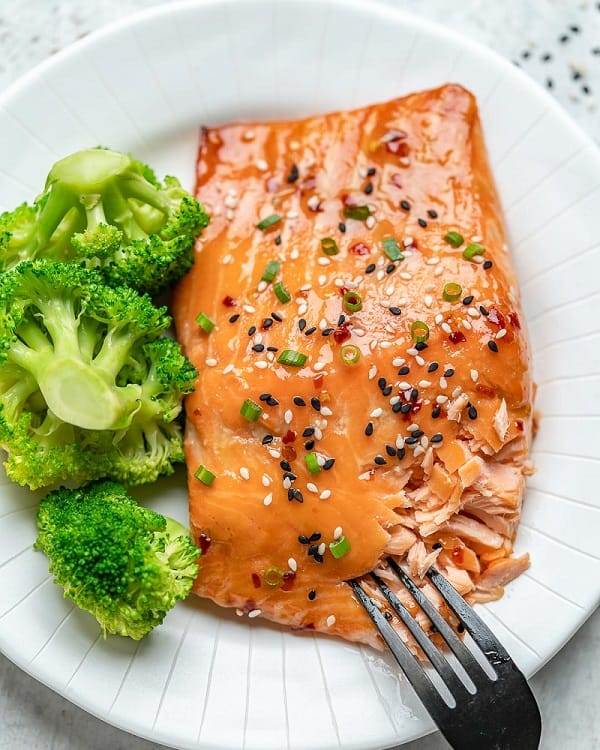
Cook it at 400°F in the oven; it usually takes between 12 and 20 minutes, depending on the thickness of the fillet or the whole fish. It’s essential to pay attention to the internal temperature of the fish, which should reach 135 degrees Fahrenheit at its thickest part. For 1-inch-thick fillets, the cooking time should be around 12 minutes. Thinner fillets will require shorter baking time, while larger pieces may need up to 15 minutes.
Cooking salmon in foil is a popular method that helps retain moisture and flavor. Let the fish rest for a few minutes before serving to ensure it’s cooked fully and evenly. Baking salmon at 400°F is quick and easy, making it a perfect option for busy weekdays or special occasions.
How Long Does It Take to Bake Salmon At 400 In The Air Fryer?
Did you know that salmon can be cooked to perfection in an air fryer in just a matter of minutes? On average, it takes about 7-9 minutes at 400°F for the salmon to be cooked perfectly. However, depending on the thickness of your fillets, the cooking time may vary from 6 to 11 minutes. It’s important to keep an eye on the internal temperature of your salmon to ensure it’s fully cooked.
If you’re cooking from frozen, it’s recommended to use a higher temperature of 400°F and cook for approximately 15 minutes. Don’t forget to add other ingredients, like asparagus, midway through the cooking process. In no time, you can enjoy juicy and tender air fryer salmon!
How Long Does It Take to Bake Salmon at 400 on the Grill?
When grilling salmon, the cooking time can vary depending on the fillet’s size and the grill’s temperature. A good rule of thumb is to grill salmon at 400°F for 10-12 minutes per pound. For example, a 1-pound fillet should be cooked 10-12 minutes. Grilling salmon at 400°F, it will take approximately 10 to 20 minutes for the salmon to be fully cooked.
It’s always a good idea to check the thickest part of the fillet with a fork to ensure it is cooked through. Additionally, flipping the fillets halfway through cooking can help ensure even cooking on both sides. Perfectly grilled salmon is easy to achieve with a smoking hot grill and a little attention!
How Long Does It Take to Bake Marinated Salmon at 400?
If you are looking for a delicious way to prepare salmon, consider baking it with a tasty marinade. But how long will it take to cook? According to factual data, a marinated salmon fillet should be baked at 400 degrees Fahrenheit for 12-15 minutes.
However, it’s important to note that the cooking time can vary depending on the thickness of the salmon. To ensure it’s fully cooked, the salmon should be flaky when pressed with a fork or reach an internal temperature of 140 degrees Fahrenheit.
How Long Does It Take to Bake Sockeye Salmon at 400?
When baking sockeye salmon, the oven’s temperature plays a crucial role. An oven temperature between 350°F and 400°F will give a lovely baked salmon dish. However, the hotter the oven, the quicker the cooking time. On average, it takes around 20-25 minutes to bake sockeye salmon at 400°F, but cooking times may vary depending on the thickness of the fillet. Generally, bake salmon for 10-12 minutes per inch of thickness at 425°F to get perfectly baked salmon that is moist and flavorful.
It’s important to ensure the salmon is not overcooked, as this can cause it to dry out and lose its flavor. When the thickest part of the salmon turns bright red, it indicates that it’s perfectly baked and ready to be served.
How Long Does It Take to Bake Frozen Salmon at 400?
When baking frozen salmon at 400 degrees, the cooking time can vary depending on the size of the fish and the oven. However, the general recommendation is to bake the fish for 25-30 minutes or until the internal temperature reaches 145 degrees Fahrenheit. To achieve the desired temperature, one can add 7 1/2 minutes to the estimated baking time of 15 minutes.
On the other hand, Sockeye salmon should be baked for 10-15 minutes at 400 F. To ensure even cooking, the fish should be rinsed before placing it in the preheated oven. It’s important to check the salmon’s flakiness before serving it, as it indicates that it’s cooked properly. One can easily bake frozen salmon at 400 degrees with these simple steps.
How Long to Bake 1 Lb Salmon at 400 Degrees Fahrenheit?
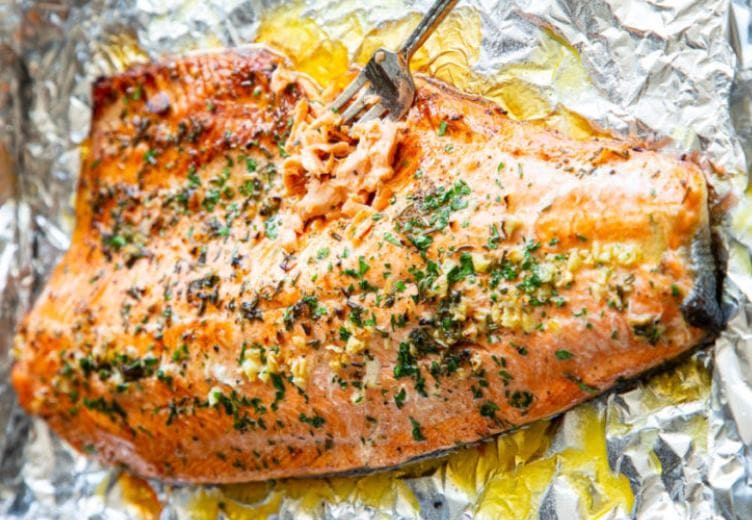
To be factual, it usually takes between 15 to 20 minutes. However, it’s essential to check the internal temperature of the fish to ensure it’s fully cooked. The recommended temperature for cooked salmon is 135 degrees at its thickest inner part. Using a digital cooking thermometer can help you achieve accurate results.
It’s vital to note that the cooking time may vary depending on the thickness of the fillet, so adjusting the cooking time accordingly is advisable. To bake the perfect 1 lb salmon fillet, preheat the oven to 400 degrees Fahrenheit and place the fish on a baking sheet lined with aluminum foil or parchment paper. Then, bake for around 15 to 20 minutes, and you can enjoy deliciously cooked salmon.
What Is The Recommended Cooking Time For A 1-Inch Thick Salmon Fillet At 400 Degrees?
If you plan on baking a 1-inch thick salmon fillet at 400 degrees, the recommended cooking time is around 12-15 minutes. This time may vary depending on the size and thickness of your fillet, so it’s important to keep an eye on the internal temperature of the fish.
The general rule is to cook salmon for 10 minutes per inch of thickness at 400 degrees, so a 1-inch thick fillet should take around 12 minutes to cook fully. It’s best to allow the fish to rest and come up to temperature before serving and check that the internal temperature has reached 135 degrees at its thickest, most internal part. Overall, it’s important to focus on the temperature of the fish rather than just the cooking time, as this will ensure your salmon is cooked to perfection every time.
Related Reading:
- How Long Does Cooked Salmon Last In The Fridge
- How Long To Bake Salmon At 425
- How Long to Bake Salmon at 350 Degrees
What Is The Recommended Internal Temperature For Salmon When Baking It At 400 Degrees?
When baking salmon at 400 degrees Fahrenheit, it is recommended to cook it to an internal temperature of 145°F. This temperature ensures the salmon is perfectly cooked while retaining its moist, buttery texture. The best way to determine if salmon is done cooking is by using a digital thermometer to check its internal temperature. Insert the thermometer into the thickest part of the fish and ensure it reads between 145-165 degrees Fahrenheit. Cooking salmon at too high or too low of a temperature can lead to dry, overcooked, or undercooked fish, which may not be as flavorful.
Is There A Specific Method To Seasoning Salmon Before Baking It At 400 Degrees?
When it comes to seasoning salmon before baking it at 400 degrees, there are a few methods that I have found to be particularly effective. Here are my top recommendations:
- Salt and Pepper: Sometimes, the simplest methods are the best. For a classic, no-fuss seasoning, I like to sprinkle salt and pepper over my salmon fillets before baking them at 400 degrees. This allows the natural flavor of the salmon to shine through while still adding a touch of seasoning to enhance it.
- Lemon and Herb: I like combining lemon and herbs for a fresh and flavorful twist on baked salmon. Squeeze fresh lemon juice over the salmon fillets and sprinkle them with chopped herbs like thyme, rosemary, and parsley. This adds a bright, citrusy flavor and a touch of earthiness from the herbs.
- Soy Sauce and Ginger: For an Asian-inspired seasoning, I like to brush my salmon fillets with a mixture of soy sauce, minced ginger, and garlic before baking them at 400 degrees. This creates a savory, umami-rich flavor perfect for pairing with steamed rice and stir-fried vegetables.
- Cajun Spice Blend: If you’re looking for a bold and spicy seasoning, a Cajun spice blend is a great option for baked salmon. I like to mix paprika, cayenne pepper, garlic powder, onion powder, and thyme to create a flavorful rub for my salmon fillets. This adds a smoky, spicy kick that pairs well with roasted vegetables or a creamy side dish like mashed sweet potatoes.
Regardless of your seasoning method, brush your salmon fillets with olive oil before baking them at 400 degrees. This helps to keep the fish moist and prevents it from sticking to the baking sheet.
How Can You Protect The Delicate Texture Of Salmon While Baking It At High Temperatures?
After some trial and error, I’ve discovered a few tips and tricks that can help you protect the delicate texture of salmon while baking it at high temperatures.
First and foremost, it’s important to start with a good quality piece of salmon. Look for salmon that is firm to the touch and has a bright, vibrant color. This will ensure your salmon is fresh and will hold up better during baking.
Next, consider marinating your salmon before baking. A simple marinade of olive oil, lemon juice, and herbs can do wonders for adding flavor and moisture to your salmon. Let the salmon marinate in the refrigerator for at least 30 minutes before baking.
When it comes to baking, I recommend using a high temperature of around 425°F. This will help to create crispy skin and seal the moisture of the salmon. Be sure to preheat your oven before baking to ensure even cooking.
To protect the delicate texture of the salmon, I suggest baking it in a lightly oiled baking dish or on a sheet of parchment paper. This will help to prevent the salmon from sticking to the pan and drying out.
Finally, keep a close eye on the salmon while it bakes. Depending on the thickness of the salmon, it may only need to be baked for 10-15 minutes at such a high temperature. Overcooking the salmon can easily lead to a tough and dry texture.
How to Bake Salmon at 400?
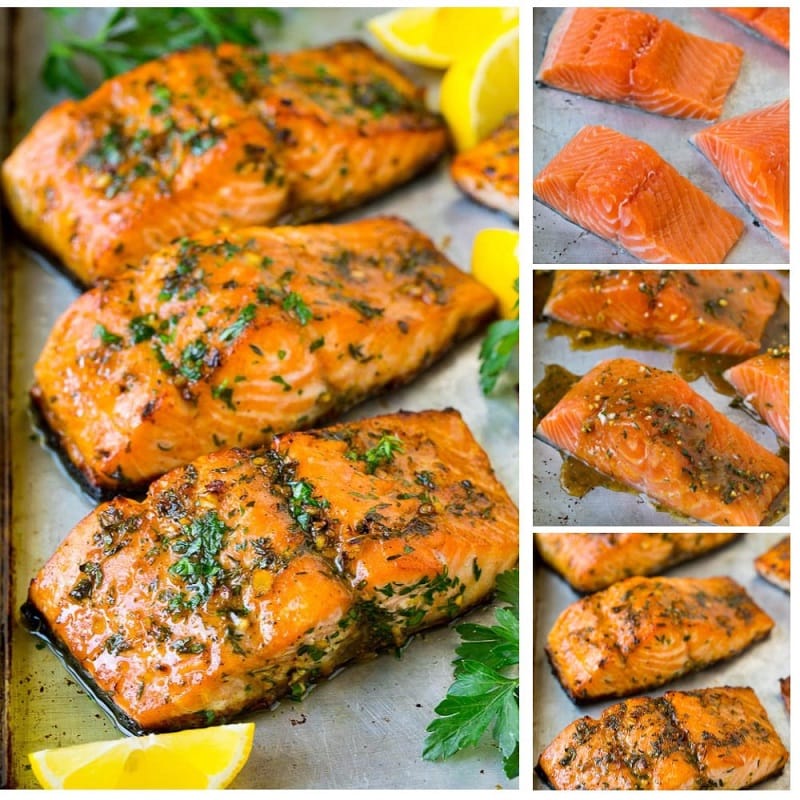
Today, I’m going to share with you my go-to recipe for baking salmon at 400 degrees. This recipe is super easy and quick to make, and it always results in perfectly cooked, juicy salmon.
First things first, let’s gather our ingredients. You’ll need the following:
- 1 1/2 pounds of salmon (either a single portion or 4 6-ounce fillet portions)
- 1 1/2 tablespoons of extra virgin olive oil
- Seasonings of your choice (such as salt, pepper, seafood seasoning, Cajun seasoning, etc.), and some fresh herbs and lemon wedges for serving (optional).
Now, let’s get started!
- Preheat your oven to 400 degrees F and line a 9×13-inch baking dish with parchment paper. Pat your salmon dry, then arrange it in the center of the pan (if using fillet portions, make sure they don’t touch).
- Drizzle the salmon with the olive oil, then add your seasonings of choice. I love using a mix of salt, pepper, and Cajun seasoning, but feel free to use whatever you like!
- Now, it’s time to bake the salmon. Pop it in the oven at 400 degrees F for 11 to 14 minutes for 6-ounce fillets or 15 to 18 minutes for a single side. You’ll know it’s done when it registers at 135 degrees F on an instant-read thermometer inserted at the thickest part of the salmon.
- Once the salmon is done, take it out of the oven and rest for 5 minutes. This will allow the juices to redistribute throughout the fish, resulting in a more tender and flavorful meal.
- Finally, it’s time to serve your delicious baked salmon! Sprinkle some fresh herbs on top and squeeze a lemon wedge over it. And that’s it! A perfectly cooked, healthy meal that’s ready in no time.
I hope you enjoyed this simple recipe for baking salmon at 400 degrees. Remember, you can always mix the seasonings and herbs to suit your tastes. So next time you’re in the mood for some delicious seafood, try this recipe!
How Can You Tell When Salmon Is Fully Cooked?
Overcooked salmon can be dry and tough, while undercooked salmon can be dangerous. So, how can you tell when salmon is fully cooked? Here are a few things I’ve learned over the years:
- Check the internal temperature. A digital thermometer is the most straightforward and foolproof way to tell if salmon is fully cooked. Cook the salmon until it reaches an internal temperature of 145°F (63°C). Insert the thermometer into the thickest part of the salmon, ensuring it doesn’t touch the bone. You can use a fork to check the internal temperature if you don’t have a thermometer. Gently flake the salmon with a fork and check the color inside. Fully cooked salmon will be opaque and bright pink.
- Look for white protein. Another visual clue that salmon is fully cooked is the appearance of white protein on the surface of the fish. This protein is visible as small white dots or flakes, indicating the salmon has cooked through. Keep in mind that this method is not as reliable as using a thermometer, so it’s always best to double-check the internal temperature before serving.
- Watch the texture. When fully cooked, salmon will be firm to the touch but still moist and tender. Overcooked salmon will be dry and flaky, while undercooked salmon will be soft and raw. If you’re unsure about the texture, use a fork to flake the salmon gently. Fully cooked salmon should be flaky but still hold together.
- Pay attention to the timing. The cooking time for salmon can vary depending on the thickness of the fillet and the cooking method. Generally, salmon should be cooked for about 12-15 minutes per inch of thickness. It’s also important to let the salmon rest for a few minutes after cooking to allow the juices to redistribute and the fish to finish cooking. The internal temperature will continue to rise during this time, so recheck the temperature before serving.
Tips for Cooking Salmon in the Oven
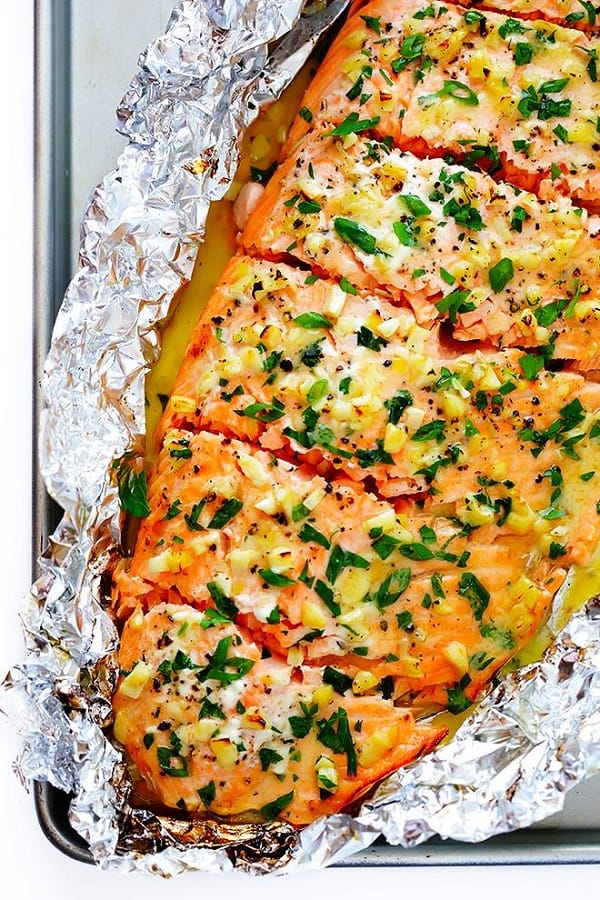
I will share some tips for cooking salmon in the oven that is easy to follow and will make your salmon turn out delicious every time.
- Preheat your oven: Preheating the oven is crucial to get the perfect cook on your salmon. Set your oven to 375°F and let it preheat for at least 10 minutes before cooking.
- Choose the right pan: A baking sheet or a casserole dish works well for cooking salmon. Ensure the pan is large enough to hold the salmon without overcrowding.
- Season your salmon: Season your salmon with salt, pepper, and other herbs or spices. Use a brush or your hands to rub the seasoning all over the salmon, making sure to coat it evenly.
- Add some moisture: Salmon tends to dry out quickly in the oven, so it’s essential to add some moisture to keep it moist. You can drizzle some olive oil or lemon juice on the salmon or place some lemon slices on top.
- Use a thermometer: A thermometer is the best way to ensure your salmon is perfectly cooked. Insert the thermometer into the thickest part of the salmon, and it should read 145°F when the salmon is fully cooked.
- Let it rest: Once you take the salmon out of the oven, rest for a few minutes before serving. This will allow the juices to redistribute, making the salmon more tender and flavorful.
Some Recommended Side Dishes To Serve With Baked Salmon
Here are some of my recommended side dishes to serve with baked salmon.
- Roasted Vegetables: Roasting vegetables is a great way to add depth and texture to your meal. I like to roast a combination of broccoli, carrots, and sweet potatoes. Season with salt, pepper, and olive oil before roasting in the oven.
- Quinoa Salad: Quinoa is an excellent source of protein and pairs well with salmon. I like to make a simple quinoa salad with cucumbers, tomatoes, and a lemon vinaigrette. It’s light and refreshing and doesn’t overpower the salmon.
- Garlic Mashed Potatoes: Garlic mashed potatoes are always a hit if you’re looking for a more indulgent side dish. Boil some potatoes until tender, then mash them with butter, garlic, and milk. So simple, yet so delicious.
- Steamed Asparagus: Asparagus is a great side dish for salmon because it’s light and doesn’t overpower the fish. Steam the asparagus and season with salt, pepper, and lemon juice.
- Mixed Greens Salad: A mixed greens salad is always a good choice for a side dish. I like combining arugula, spinach, and kale and dressing it with a simple balsamic vinaigrette.
What Is The Best Way To Serve Baked Salmon For A Dinner Party?
The best way to serve baked salmon is with a simple yet flavorful accompaniment. My go-to side dish for baked salmon is a lemon-dill sauce.
I combine freshly squeezed lemon juice, chopped fresh dill, mayonnaise, and a touch of honey to make the sauce. The result is a tangy and creamy sauce that pairs perfectly with the rich flavors of baked salmon.
When it comes to cooking the salmon itself, I prefer to keep it simple. I season the salmon with salt, pepper, and a little bit of olive oil before placing it in the oven. Depending on the size of the fillet, it usually takes around 12-15 minutes to cook through.
As for the presentation, I like to serve the salmon on a large platter with lemon-dill sauce drizzled over the top. I also like garnering the platter with fresh lemon slices and sprigs of dill.
Another thing to keep in mind when serving baked salmon is the temperature. Serving the salmon hot out of the oven is important to ensure it is at its best.
How to Store Baked Salmon?
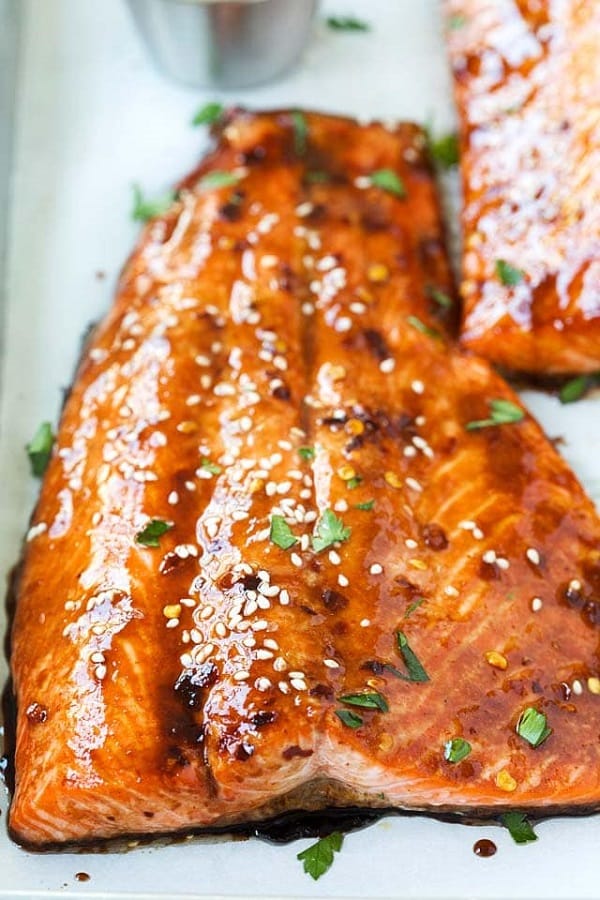
Here, I’ll be sharing some tips on correctly storing baked salmon.
First and foremost, it’s essential to let your salmon cool down to room temperature before placing it in the fridge. Putting hot food in the fridge can raise the temperature of the fridge, which can lead to other foods spoiling faster.
Once your salmon has cooled down, it’s time to store it. The best way to store baked salmon is in an airtight container or resealable plastic bag. Make sure that you remove as much air as possible from the bag or container before sealing it. This will help prevent the salmon from drying out and keep it fresher for longer.
Another essential tip when storing baked salmon is to keep it in the coldest part of the fridge. The back of the refrigerator is usually the coldest area, so try to store your salmon there. Ensure that your fridge temperature is below 40°F (4°C), as this is the ideal temperature for storing cooked fish.
Consuming your stored baked salmon must also be consumed within three to four days. After that, it’s best to throw it away to avoid the risk of food poisoning.
You can freeze your baked salmon if you want to store it for longer than a few days. To freeze baked salmon, wrap it tightly in plastic or aluminum foil and place it in an airtight container. Label the container with the date to know when you stored it. Frozen baked salmon can last up to three months in the freezer.
How to Reheat Baked Salmon
Sometimes you may end up with leftovers and wondering how to reheat baked salmon without sacrificing its taste and texture. Here is how I reheat baked salmon to perfection:
- Preheat the oven to 275°F.
- Remove the salmon from the refrigerator and let it sit at room temperature for 10 minutes.
- Place the salmon on a baking sheet or oven-safe dish.
- Cover the salmon with foil to prevent it from drying out.
- Place the baking sheet or dish in the preheated oven.
- Reheat the salmon for 10-15 minutes or until it reaches an internal temperature of 145°F.
- Remove the salmon from the oven and let it rest for a few minutes before serving.
It’s important to note that reheating baked salmon in the microwave is not recommended as it can cause the fish to become rubbery and dry. The oven method ensures that the salmon stays moist and retains its flavor.
FAQs
How Can I Prevent My Salmon From Drying Out?
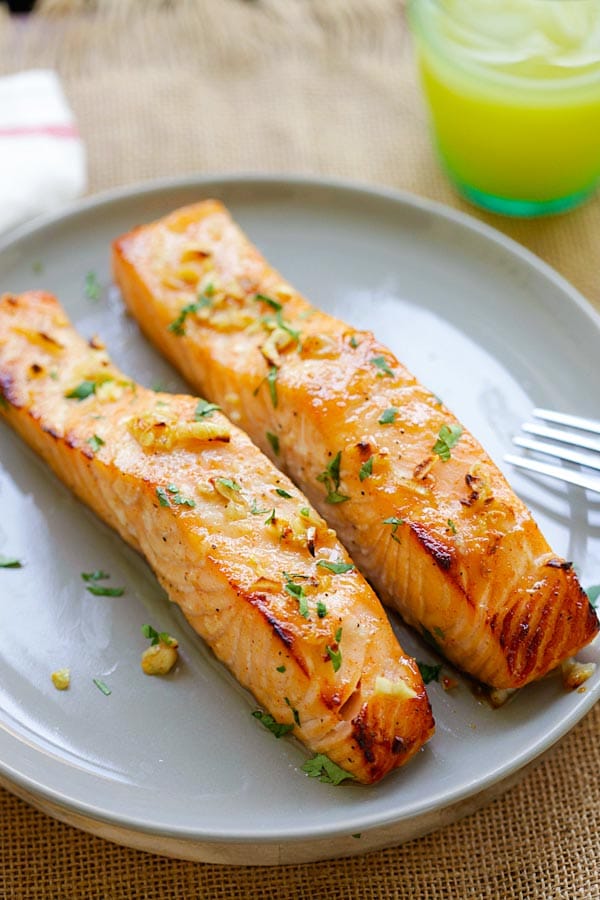
As a first step, consider bringing your salmon in saltwater before cooking it. This will help the fish retain its moisture and add extra flavor. Additionally, using a “barrier” like olive oil or butter while baking can protect the fillet from drying out. Preheating an air fryer for several minutes is also essential when cooking salmon.
Another way to ensure moist and flavorful salmon is to leave the skin on while cooking. It provides a safety layer to the fish and keeps it from drying out too quickly. Other helpful tips include a medium-low stovetop heat, avoiding steaming, coating the fillets with olive oil, and starting with a hot pan to prevent skin from sticking.
How Long Do You Need To Marinate Salmon Before Baking It?
Marinating is a great option to add extra flavor to your salmon before baking it. Based on factual data, a minimum of 30 minutes to 1-2 hours is recommended depending on the size of the fish and the type of marinade being used.
However, marinades containing acid, such as lemon juice or vinegar, should not be left for 30 minutes as they can start cooking the fish. The 5-ounce salmon fillet can be marinated for at least four hours by covering it with plastic wrap and keeping it in the fridge. If marinating for longer than the recommended time, the texture of the fish may become compromised. Once marinated, the salmon can be baked at 400 degrees Fahrenheit for around 15 minutes, depending on its thickness. Brushing it with the reserved marinade before serving will enhance its flavor. While marinating isn’t necessary for cooking salmon, it can add flavor to the dish.
How Do You Avoid Overcooking Salmon While Baking It At 400 Degrees?
Typically, salmon takes 15 to 20 minutes to cook at this temperature if baked in foil. However, focusing on the internal temperature is crucial, as overcooking the fish can result in a dry and tough fillet. To avoid this, it’s best to leave the salmon uncovered and use a meat thermometer to check the internal temperature. Once the salmon reaches an internal temperature of 145 degrees Fahrenheit, it’s time to take it out of the oven. After removing it from the heat or oven, cover it and let it rest for a few minutes before serving.
Do You Flip Salmon In The Oven?
When baking salmon in the oven, there is no need to flip it over. The skin side should always be facing down, whether or not it is left on. It is important to brush the skin with oil to help prevent sticking. Additionally, salmon can be baked at a temperature of 375°F for 15 minutes or 350°F for 20-25 minutes for a gentler approach. While broiling is quicker, it should be monitored carefully to prevent burning.
Is It Better To Bake Salmon At 350 Or 400?
When baking salmon, there isn’t a one-size-fits-all answer to the question of which temperature is best. However, based on factual data, it’s been found that baking salmon at 400 degrees Fahrenheit is the perfect temperature to cook the fish and get crispy skin. This temperature range will cook the salmon in about 10-15 minutes per inch of thickness, resulting in a tender, flaky fish well cooked.
However, some people prefer a gentler cooking method, and in that case, baking salmon at 350 degrees Fahrenheit for 20-25 minutes or until fully cooked is a great option. It’s important to consider what type of salmon you’re cooking, whether it’s dressed or marinated, and whether you’re cooking it with other ingredients.
Preheating the oven to the desired temperature and using a lightly-oiled sheet pan or shallow baking dish is recommended regardless of your chosen temperature. Ultimately, how they want to enjoy their salmon also determines the temperature to bake it.
How Does The Cooking Time And Temperature Vary For Baking Salmon Fillets Vs? Whole Salmon?
When it comes to cooking salmon, the cooking time and temperature can vary depending on whether you are baking salmon fillets or whole salmon. For baking salmon fillets, the cooking time will typically take between 10-20 minutes in the oven at 375°F to 400°F, depending on the thickness of the fillet. On the other hand, baking a whole salmon can take around 45-60 minutes from 350°F to 375°F, again depending on the size and weight of the fish.
It is essential to keep in mind that the internal temperature of the salmon should reach at least 145°F to ensure it is cooked thoroughly. It is always a good idea to check the fish occasionally during cooking to avoid over or undercooking. Regardless of the method chosen, baking salmon is a delicious and healthy way to enjoy this popular fish.
How Can You Determine The Internal Temperature Of A Salmon While Baking It?
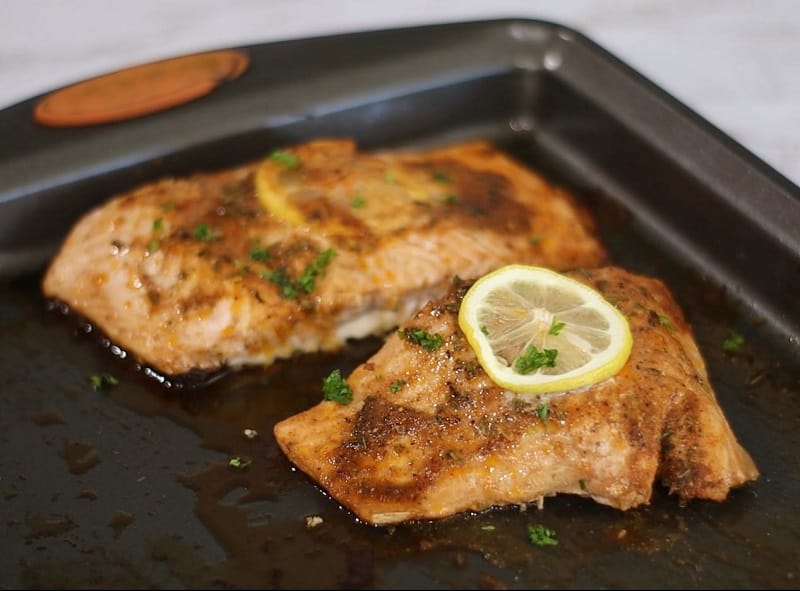
If you’re baking salmon, it’s important to ensure it’s cooked to the right internal temperature for safety and flavor. So how can you determine the internal temperature of a salmon while baking it? One of the best ways is to use a food thermometer. Please insert it into the thickest part of the fish, ensuring it doesn’t touch the bone or the bottom of the pan. When the internal temperature reaches 125-130°F in the center, it’s considered medium cooked, a popular preference for many salmon lovers. However, if you prefer fully cooked salmon, aim for an internal temperature of 145°F, according to the USDA.
Is It Necessary To Wrap The Salmon In Foil While Baking It At 400 Degrees? If So, How Long Should It Be Wrapped For?
When baking salmon in the oven at 400 degrees, wrapping it in foil is a popular technique. Not only does it help to keep the moisture of the fish intact, but it also helps to infuse the flavors of any added ingredients. It is recommended to wrap the salmon in foil and bake it for 15 to 20 minutes or until it reaches an internal temperature of 145°F at its thickest part. This ensures that the salmon is cooked through but still tender and juicy. While it may take a few extra minutes to wrap the salmon in foil, it is worth it for a delicious and nutritious meal.
Conclusion
In conclusion, if you’re wondering how long to bake salmon at 400 degrees Fahrenheit, aim for 12-15 minutes and check the internal temperature for doneness. Don’t forget to let it rest before serving. With these simple tips, you’ll be able to impress your dinner guests with a delicious and perfectly cooked salmon fillet every time.
References:
- https://www.wellplated.com/grilled-salmon-in-foil/
- https://www.allrecipes.com/recipe/71387/best-salmon-bake/
- https://therecipecritic.com/air-fryer-salmon/
- https://www.finedininglovers.com/article/how-to-bake-salmon-oven

Hey readers! Chip Holland here, and I’m a Manager of this website. My passion for writing about it only matches my passion for BBQ. Follow my blog for mouth-watering recipes, tips, and tricks for the perfect smoke, grill, and BBQ. I’m sure you won’t be disappointed!
